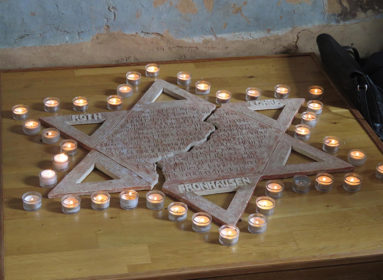
By Cindy Mindell
Thirty years after his death, Marc Chagall continues to draw admirers to his artwork, renowned for its colorful and romantic portrayals of 19th-century shtetl life. Acclaimed by art historians over the last century as one of the greatest figures of modern art, Chagall is the subject of countless academic works and exhibitions.
Bella Meyer inhabits a unique perch at the crossroads of the personal and the academic conversations about Chagall. An art historian by training, Meyer is also Chagall’s granddaughter and an artist in her own right. She will bring her unique perspective to Congregation B’nai Israel in Bridgeport on Friday, Feb. 6. Meyer was invited to the synagogue by Rabbi James Prosnit, a distant cousin of her late husband, Martin Kace, and the officiant at the couple’s wedding.
Meyer, 58, was born in Paris to Ida Meyer, the only child of Chagall and his first wife, Bella Rosenfeld. Meyer and her brother and twin sister grew up in Basel, Switzerland, where their father, Franz, was an art historian and director of the Kunstmuseum. The three children spent summers with their grandfather in southern France, where he lived until his death in 1985.
Marc and Bella Chagall had left behind their Chasidic upbringing to pursue a life among fellow artists and intellectuals in Europe and the U.S. There imagery of Eastern European Jewish life in Chagall’s paintings belie his secular life, which was passed down to his grandchildren.
“Unfortunately, we didn’t grow up with any knowledge that we were Jewish,” Meyer says. “That knowledge was never given to me until I was looking for it myself.”
After earning a PhD in medieval art history from the Sorbonne in 1980, Meyer moved to Manhattan, where she works as cultural attaché to the French Embassy and worked as a designer in various milieus. It was a flower-bedecked chuppah she created for a friend that set Meyer on a more defined artistic path. She launched Fleurs Bella floral design in Manhattan just over a decade ago, and opened the Fleurs Bella shop in 2009.
It’s easy to assume a direct artistic influence between Chagall and his granddaughter.
“My mother was always very connected to her father; we would go visit him very often, and we talked about him and his work all the time,” Meyer says. “It was ever-present; his paintings were hanging at home and he was a complete part of my upbringing and kind of the center of attention.”
Whether directly influenced by her grandfather or not, Meyer painted from early on, simply because she liked to.
“I admired him, I revered him; he was most important to me,” Meyer says.
Meyer keeps alive the essential spirit of Chagall’s work, which is often at the heart of her public presentations.
“Art in general remains a very important part of our civilization, and my grandfather’s work still has an impact on people: it does indeed stir up lots of feelings in viewers because it’s so personal,” she says. “Many people are very attracted to his work because he never compromised; his art is really driven by his heart. He tried to find the ideal through his work.”
Chagall’s ethos echoes in Meyer’s own art. “It’s important for me to try to be as honest as possible with whatever I do, in whatever field,” she says. “In that sense, he influenced me very much.”
Meyer’s presentation is part of Congregation B’nai Israel’s “Celebrating Our Artists” program, from Feb. 5 to 15. For more information: cbibpt.org / (203) 336 – 1858. Meyer will also speak on Sunday, Mar. 29 at Temple Sinai, 458 Lakeside Drive in Stamford. For more information: Jewish Historical Society of Fairfield County, jhsfc-ct.org.









 Southern New England Jewish Ledger
Southern New England Jewish Ledger














